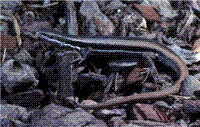Family
Scincidae (Skinks)
Genus
Morethia
Species
boulengeri
Threats/Control Methods - Regional
As with many species, urban expansion into previous habitat areas in northern Canberra is likely to lead to a drop in local population numbers, as urban areas provide less habitat for the skink.
Threats/Control Methods - Local
Threats to the skink in the urban area include 'cleaning up' of debris and leaves which is important habitat. This may at times need to be done for fire mitigation purposes.
Local/Urban Actions
Important steps that can be made in the Canberra urban area include having appropriate structures in gardens and nature reserves such as fallen timber and leaf litter.
Common name/s
Boulenger's Skink, Boulenger's Morethia
Distinguishing Features
The upper side of lizard is grey-brown, with flecks of darker and lighter coloured scattered through. A conspicuous white stripe runs from the lips to the hind legs along the side of the body and the species has a white underside. Males in breeding season have a reddish-orange throat. Juveniles of the species tend to have a red flush to the tail. The Boulenger's Skink can grow to a total length of around 10cm, but average lizards are shorter at around 8cm. The tail makes up a little under half the length, and can be lost if the lizard is threatened.
Similar Species
In the ACT, the skink most closely resembling the Boulenger's Skink is the Garden Skink (Lampropholis guitchenoti). The Garden Skink often has a coppery coloured head and a dark strip down the centre of the back that is lacking on the Boulenger's Skink.
Distribution
The Boulenger's Skink can be found in most inland parts of south-eastern Australia, spanning all states and the Northern Territory. The lizard is not found in Tasmania. In the ACT, it is only found in the warmer northern and eastern areas.
Country of Origin
Australia
Survey Techniques
As with other lizard species, pitfall trapping and hand searching can be used to locate the lizard in survey work.
Conservation (Pet/Pest) Status - National
Not listed in a threatened category under the EPBC Act 1999
Conservation (Pet/Pest) Status - Regional
Not listed as threatened in the ACT
LSCCES Population
No data available, however, expansion of suburban Canberra into the lizard's habitat is likely to reduce population numbers locally.
Associated vegetation community
Dry sclerophyll forest, woodlands and mallee.
Limiting Resources
Suitable habitat structures, such as fallen timber and adequate ground litter are an important limiting factor in most of the urban area.
Breeding
The Boulenger's Lizard breeds in spring and lays up to six eggs per clutch, with multiple clutches possible in one season. The eggs hatch around two months later.
Behaviour
A diurnal species, usually found in ground litter or sheltering under bark on fallen trees. In warmer parts of its range, it may be active year round, but in the Canberra region, its activity is restricted in the colder months.
Functional Group
Insectivore
Food Species
The lizard feeds on spiders, termites, ants and other invertebrates.
Predators
The lizard is preyed upon by other skinks including Ctenotus species, snakes and birds including Butcherbirds, Kingfishers and Magpie Larks.
Interesting Fact
The Boulenger's Skink can quickly burrow into soft soils if threatened.
References - (reader suitability of references, P=Primary teachers, S=Secondary students, T=Tertiary students and researchers)
Books:
Bennett, R. 1997. Reptiles & frogs of the Australian Capital Territory. National Parks Association of the ACT, Woden. S, T
Cogger, H.G. 1996. Reptiles and Amphibians of Australia. Reed Books Australia, Melbourne. S, T
Swan, G., Shea, G. and Sadlier, R. 2004. A Field Guide to Reptiles of New South Wales. Second Edition. Reed New Holland, Sydney. S, T
Internet:
Bennett A, Kimber A and Ryan P. 2000. "Revegetation and Wildlife: A Guide to Enhancing Revegetation Habitats for Wildlife Conservation in Rural Environments". Department of the Environment and Water Resources, Canberra.http://www.environment.gov.au/land/publications/revegwild/revegwild3.html [Last accessed 8/5/07]
Greer, A.E. 2006. Encyclopedia of Australian Reptiles. Australian Museum Online, Version date: 7 August 2006. Thttp://www.amonline.net.au/herpetology/research/index.htm#encyclopedia [Last accessed 01/05/07]
Researcher: Ian Rayner

 Top
Top Top
Top